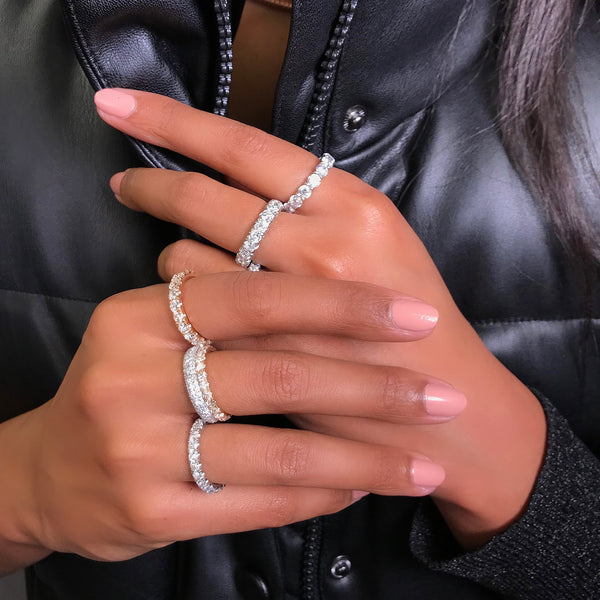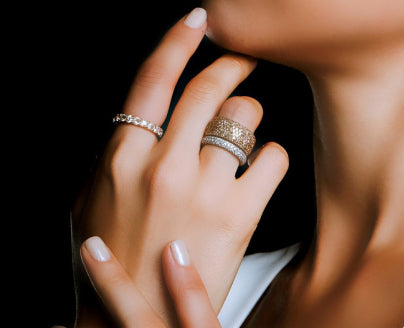
Diamond Chart
Are you considering investing in a diamond ring, but you’re not sure where to start? Whether you’re selecting an engagement ring for the love of your life, or indulging in a sparkling stone for yourself, you should always consider the 4Cs of Diamond Buying: Cut, Color, Clarity, and Carat. Learn all you need to know about the 4Cs with master jeweler and diamantaire David Alan.
What Are The 4Cs Of Diamonds?
The 4Cs of diamonds are the key factors that determine a diamond’s quality. The 4C’s are: Cut, Color, Clarity and Carat.
Cut: Cut is arguably the most important C. A diamond’s cut bears significant influence on its beauty and ability to sparkle. Cut should not be confused with shape. The cut determines how the diamond has been cut or fashioned and how well a diamond’s facets interact with light. The more precise a diamond’s cut is, the more brilliant and sparkly the diamond will be, all other C’s being the same.
Color: Diamond color actually refers to the absence of color in diamonds. Color can range from colorless, which is the most expensive and incredibly rare, to a light yellow or brownish hue, which are more common and less valuable. A chemically pure and structurally perfect diamond has no hue, and thus a higher value. Colorless diamonds are graded on a scale from D to Z measuring the degree of colorlessness.
Diamonds also occur in nature with no human intervention. Coveted and rare hues include pink, red, blue and yellow. These are called “fancy colored” diamonds which use a different chart to determine grading.
Clarity: Diamond clarity assesses any imperfections both on the surface and inside the diamond. Imperfections within the stone are called inclusions, while imperfections on the surface are called blemishes. The fewer inclusions and blemishes a diamond has, the better the clarity grade it receives.The Gemological Institute of America’s (GIA) Diamond Clarity Scale has 6 categories, some of which are divided, for a total of 11 specific grades.
Carat: Diamond carat means how much the diamond weighs, measured in metric carats. A metric “carat” is defined as 200 milligrams. Each carat is subdivided into 100 ‘points.’ It’s the most objective and straightforward “C” of the 4Cs.
Diamond Color Chart
Diamond color is graded using the universal GIA grading scale, which gives diamonds a letter grade from D-Z based on their absence of color. D grade diamonds are colorless, incredibly rare, and very valuable, while Z grade diamonds have a light visible hue, are quite common, and therefore less valuable.
|
Very Rare ($$$$) |
Rare ($$$) |
Widely Available ($$) |
Plentiful ($) |
|
|
D-F |
G-J |
K-M |
N-R |
S-Z |
|
Colorless |
Near Colorless |
Faint |
Very Light |
Light |
Diamond Cut Chart
The GIA Cut grading system established in 2005 is universally recognized by professionals from around the world, and is best applied to the most popular cut: standard round brilliant. This chart breaks down each of the five grades and what they mean:
|
Excellent |
Very Good |
Good |
Fair |
Poor |
|
Reflecting nearly all light with maximum fire and brilliance. |
Reflecting most light, producing comparable brilliance and fire to excellent cut, but more cost effective. |
Offers significant brilliance and fire, reflecting a large amount of light. Cut may be too shallow or deep. |
Provides a decent amount of brilliance and fire. Cut is too shallow or deep for maximum light reflection. |
Light escapes from the diamond’s sides or bottom - cut is too shallow or deep for light reflection. |
Diamond Clarity Chart
Diamond clarity grades are determined using the GIA (Gemological Institute of America) clarity scale. This scale was developed because previously, jewelers didn’t have an established and universal way to talk about diamond clarity. Using the GIA scale is now standard practice when evaluating and purchasing diamonds.
The GIA scale has six main clarity grades, some which are divided making a total of 11 different grades. Here’s a chart explaining what each grade means:
|
Highest Clarity Grade Lowest Clarity Grade |
|||||
|
FL |
IF |
VVS1, VVS2 |
VS1, VS2 |
SI1, SI2, |
I1, I2, I3 |
|
Flawless |
Internally Flawless |
Very Very Slightly Included |
Very Slightly Included |
Slightly Included |
Included |
Diamond Carat Weight
Determining carat size is the most straightforward of all the 4Cs. A diamond is measured precisely to the thousandth of a carat, or three decimal places (.003) for example, and then also rounded to the nearest hundredth. It’s also important to note that carat’s aren’t everything. A diamond’s excellence is a culmination of all of the 4Cs, not just one specific unit.
Best Tips When Purchasing A Diamond
Work directly with a master custom jeweler. Collaborating with a custom jeweler who will listen to your design ideas and budget is imperative. Look for a jeweler who will also provide a diamond and jewelry education and help comb through some of the false information available on the internet. A master jeweler, such as David Alan, will tell you where to save and where to spend to get the perfect ring.
Consider the Options. Cost saving measures might include choosing a colored gemstone, opting for a champagne or grey diamond or making an eternity band with smaller stones. Buyer beware however, opting for an alternative diamond ring does not always mean it is more affordable. Be sure to discuss all ideas with your jeweler!
Discover custom, not customary fine jewelry, designed and expertly crafted for you
David Alan is a New York City based custom fine jewelry atelier with an incredible reputation for capturing and translating your raw emotion and passion into a beautifully balanced, and distinctly unique design. Every part of your David Alan experience contributes to a jewel so personal, it becomes your signature, your talisman, and your future heirloom. Start your journey now.
Engage in a complimentary virtual consultation with David Alan, today!

